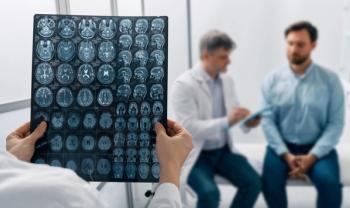
Group Calls for New Model of Care for Migraine
Current migraine care recommendations do not reflect recent advances in the scientific understanding of migraine disease.
The National Headache Foundation (NHF) has issued new migraine care recommendations challenging health insurance payers for uneven treatment of migraine patients.
The “current care models have not kept pace with the many advances in treatment,” NHF said in a statement.1
Payers should adopt care models that are patient-centric, in which the clinician—in collaboration with the patient—is the primary decision-maker and selects a treatment that addresses the patient’s treatment goals and needs, NHF said.
“Clinicians and patients are naturally upset that payers are forcing them to use older medications, some of which are not even designed for the specific treatment of migraine, even though new migraine-specific therapies now exist,” said Tom Dabertin, NHF CEO and executive director.
“For too long, migraine patients have been treated differently than others with medical issues as it related to prescription medications,” Dabertin added.
The scientific understanding of migraine has advanced considerably in recent years, bringing better tolerated and better-studied treatments to patients, most notably, anti-calcitonin gene-related petptide (CGRP) monoclonal antibodies (mAbs), oral CGRP antagonists (gepants), and agents targeting serotonin receptors, NHF noted.
“There is also growing awareness among clinicians that what was once thought sufficient efficacy for successful migraine control is, in fact, inadequate,” NHF said. “Unfortunately, the care models set by payers and the consequent treatment paradigms have not kept pace with these advances.”
NHF’s position is that the selection of a migraine therapy:
- should ultimately be determined by the clinician, in collaboration with the patient, based on the individual needs of that patient and that patient’s outcomes
- should not be determined solely by a step-care model
- should not be determined by a one-size-fits-all algorithm, including models focused predominantly on costs instead of outcomes
The organization’s specific recommendations are outlined below.
For patients with a minimum of 8 migraine days per month—a number that constitutes high-frequency or chronic migraine—NHF recommends that the clinician have the ability to select the most suitable preventive therapy, with unfettered access to FDA-approved preventive drugs, for the following reasons:
- 8 or more migraine days constitutes a significant fraction—25% or more—of the month;
- patients with less time to recover between incidents are more likely to experience a transformation to chronic migraine and more than 15 days per month; and studies suggest patients with 8 to 14 headache days/month have a level of disability similar to those with 15 to 19 headache days/month.
- For patients with a 4 to 7 migraine days per month, a modified step-care model is recommended. In this model, patients must first try 1 generic drug for migraine prevention, unless a patient has a contraindication or, per clinician judgment, should not receive it.
This list of generic drugs includes:
- Topiramate
- Divalproex, sodium valproate
- Timolol
- Propranolol
- Candesartan
- Metoprolol
- Venlafaxine
- Nortriptyline
- Amitriptyline
Topiramate, divalproex, sodium valproate, timolol, and propranolol are FDA-approved for migraine prevention. The remaining drugs are commonly used, but not have not been approved for that indication.
“If a drug from this list has failed to provide the patient with benefits in the severity and/or frequency of migraine, or is found to have intolerable side effects, the clinician should be free to select the next most suitable FDA approved preventive therapy, based on the individual patient’s needs and situation,” NHF said.
In the NHF-recommended model for preventive care, a patient is considered to have “tried and been failed by” a given drug if at least 1 of the following applies:
- The patient does not experience an adequate treatment response after a 2- to 4-month trial, where response is defined as a 50% reduction in the number migraine days per month during preventive therapy compared with the number of migraine days per month prior to the start of therapy.
- The patient cannot tolerate the drug due to its side effects, such as hypotension on beta-blockers, impaired cognition on topiramate, and weight gain on amitriptyline.
At the time of decision, the patient has a previously documented history of having “tried and been failed by” the drug due to intolerability or lack of treatment benefit.
- The patient has a comorbidity and/or other contraindications that preclude the clinician from prescribing the drug.
- For the treatment of acute migraine, NHF endorses a modified step-care model, in which patients must try 2 generic drugs: first a generic triptan, then any other generic drug, including another triptan or NSAID.
After a patient has “tried and been failed by” 2 of these generic drugs, the clinician can select another suitable therapy based on patient needs. These therapies include FDA-approved acute agents such as lasmiditan (Reyvow) or a gepant (ubrogepant [Ubrelvy], rimegepant [Nurtec ODT]; or atogepant [Qulipta]).
As with the NHF-recommended preventive care model, a patient is considered to have “tried and been failed by” a drug for acute migraine if at least 1 of the following applies:
- The patient is not migraine pain-free and functional within 2 hours of treatment after the majority of attacks OR the patient has recurrence of migraine symptoms within 24 hours following treatment.
- The patient cannot tolerate the drug due to its adverse effects (eg, tightness in the throat and/or chest with triptans).
- The patient has a documented history of the drug having proved either lacking in efficacy or intolerable due to side effects.
- The patient has a comorbidity and/or another contraindication that precludes the clinician from prescribing the drug. This list includes uncontrolled hypertension, coronary artery disease and reversible cerebral vasoconstriction syndrome for triptans or gastric ulcer disease and renal insufficiency for NSAIDs.
Reference
1. National Headache Foundation position statement on the treatment of migraine. National Headache Foundation. January 19, 2022. Accessed January 20, 2022.
Newsletter
Pharmacy practice is always changing. Stay ahead of the curve with the Drug Topics newsletter and get the latest drug information, industry trends, and patient care tips.




